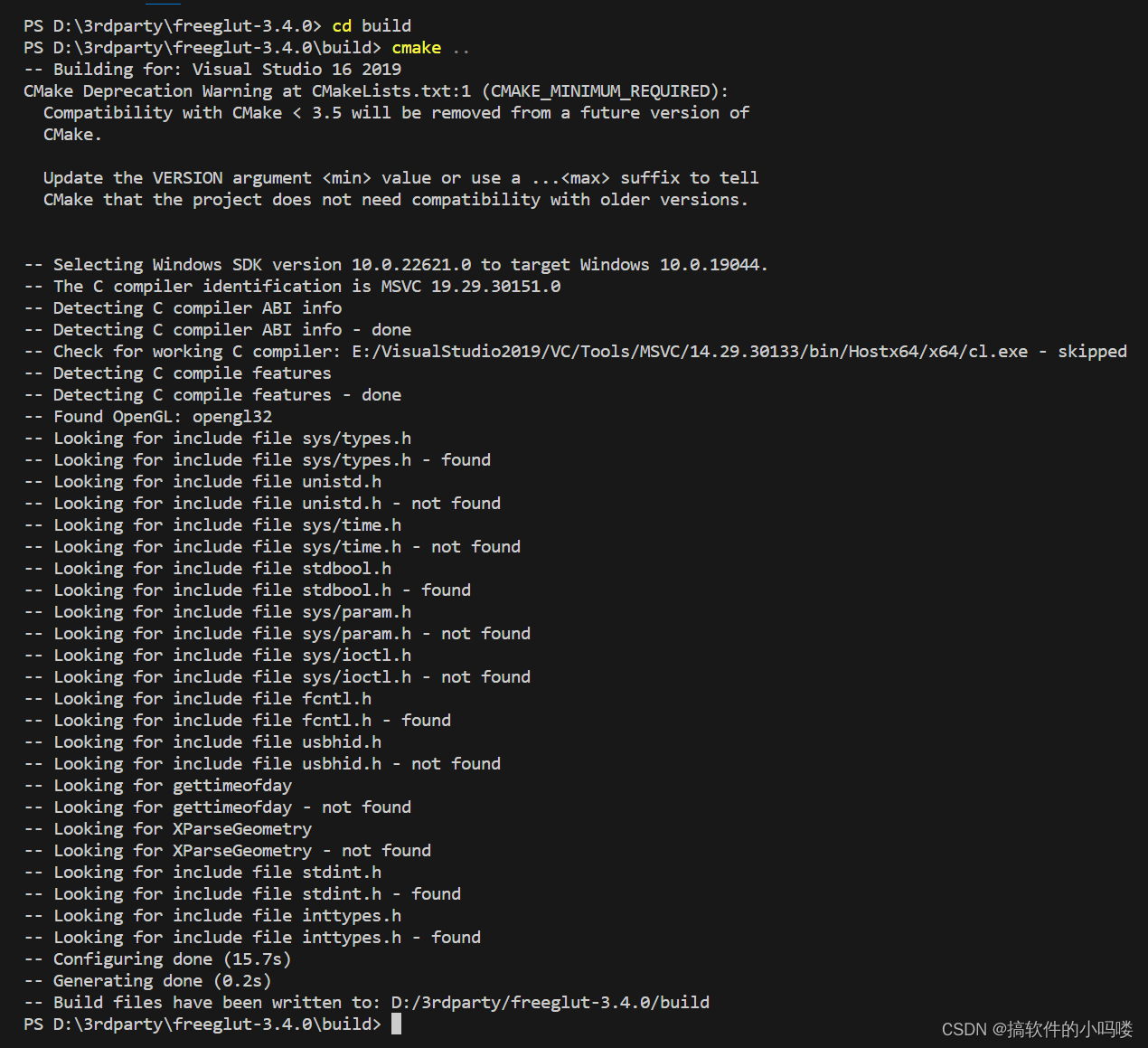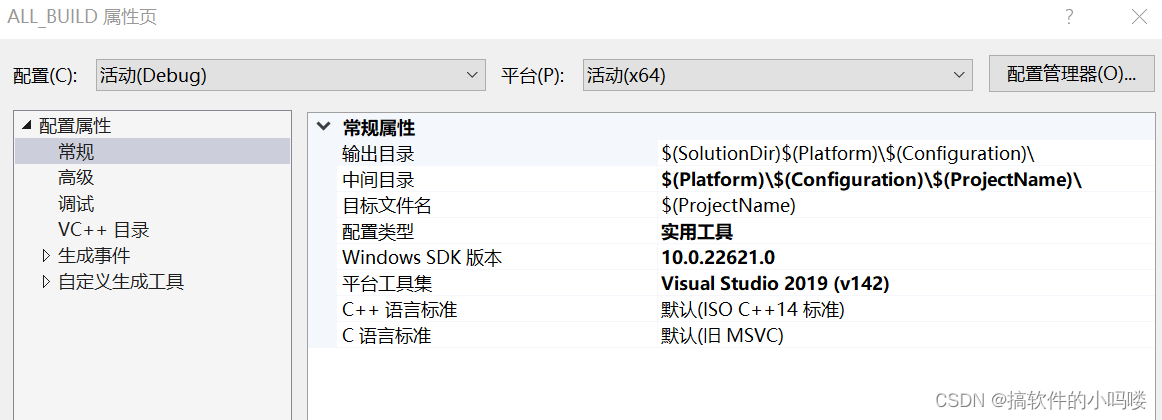一. 项目场景:
提示:这里简述项目相关背景:
目前我在使用QCustomPlot过程中,由于需要频繁添加数据并刷新图表,考虑还是开启opengl功能。但是在开启opengl之后,由于多图表显示以及自适应高分辨率的使用,导致出现了两个问题,记录如下。
1. 下载freeglut源码
freeglut官网下载地址
2. 编译freeglut源码
(1)创建build文件夹,来存放cmake编译之后产生的项目文件

(2) cmake编译
打开VsCode,打开源码文件,进入build文件夹,然后cmake

在build文件夹内生成sln项目文件

(3)我使用的是VS2019+v142工具集,选择ALL_BUILD,使用Debug和Release进行编译生成Debug和Release下的动态库文件。

生成的dll在bin文件夹中,生成的lib文件子啊lib文件夹内。


3. QCustomPlot添加OpenGl
# test.pro文件
QT += printsupport opengl
DEFINES += QCUSTOMPLOT_USE_OPENGL
win32: LIBS += -L$$PWD/../../3rdparty/freeglut/ -lfreeglut -lfreeglut_static -lopengl32
INCLUDEPATH += $$PWD/../../3rdparty/freeglut
DEPENDPATH += $$PWD/../../3rdparty/freeglut
# test.cpp
# qcustomplot开启opengl
_plot->setOpenGl(true);
二. 问题描述
正常时的图片如下:

在开启opengl之后,出现了两个问题。
问题一: 当界面上有多张qcustomplot图表时,多张图表的刷新会出现混乱。

问题二: Qt开启高分辨率自适应策略时,QCustomPlot开启opengl之后,图表内的像素比例会出现问题,导致图表显示异常。

解决方案:
问题一:
那是因为在开启opengl之后,opengl内部的上下文出现紊乱导致的。在qcustomplot.cpp内找到这个函数,添加下面代码即可。
# qcustomplot.cpp
void QCPPaintBufferGlFbo::draw(QCPPainter *painter) const
{
if (!painter || !painter->isActive())
{
qDebug() << Q_FUNC_INFO << "invalid or inactive painter passed";
return;
}
if (!mGlFrameBuffer)
{
qDebug() << Q_FUNC_INFO << "OpenGL frame buffer object doesn't exist, reallocateBuffer was not called?";
return;
}
// 添加这行代码即可
if(QOpenGLContext::currentContext() != mGlContext.toStrongRef()){
mGlContext.toStrongRef()->makeCurrent(mGlContext.toStrongRef()->surface());
}
painter->drawImage(0, 0, mGlFrameBuffer->toImage());
}
问题二:
在QCustomPlot的构造函数中,更改像素比列为从当前桌面获取。
setBufferDevicePixelRatio(QApplication::desktop()->devicePixelRatioF());
# qcustomplot.cpp
QCustomPlot::QCustomPlot(QWidget *parent) :
QWidget(parent),
xAxis(0),
yAxis(0),
xAxis2(0),
yAxis2(0),
legend(0),
mBufferDevicePixelRatio(1.0), // will be adapted to primary screen below
mPlotLayout(0),
mAutoAddPlottableToLegend(true),
mAntialiasedElements(QCP::aeNone),
mNotAntialiasedElements(QCP::aeNone),
mInteractions(0),
mSelectionTolerance(8),
mNoAntialiasingOnDrag(false),
mBackgroundBrush(Qt::white, Qt::SolidPattern),
mBackgroundScaled(true),
mBackgroundScaledMode(Qt::KeepAspectRatioByExpanding),
mCurrentLayer(0),
mPlottingHints(QCP::phCacheLabels|QCP::phImmediateRefresh),
mMultiSelectModifier(Qt::ControlModifier),
mSelectionRectMode(QCP::srmNone),
mSelectionRect(0),
mOpenGl(false),
mMouseHasMoved(false),
mMouseEventLayerable(0),
mMouseSignalLayerable(0),
mReplotting(false),
mReplotQueued(false),
mOpenGlMultisamples(16),
mOpenGlAntialiasedElementsBackup(QCP::aeNone),
mOpenGlCacheLabelsBackup(true)
{
setAttribute(Qt::WA_NoMousePropagation);
setAttribute(Qt::WA_OpaquePaintEvent);
setFocusPolicy(Qt::ClickFocus);
setMouseTracking(true);
QLocale currentLocale = locale();
currentLocale.setNumberOptions(QLocale::OmitGroupSeparator);
setLocale(currentLocale);
#ifdef QCP_DEVICEPIXELRATIO_SUPPORTED
# ifdef QCP_DEVICEPIXELRATIO_FLOAT
setBufferDevicePixelRatio(QApplication::desktop()->devicePixelRatioF()); //将代码中获取设备像素比例改成从桌面获取
// setBufferDevicePixelRatio(QWidget::devicePixelRatioF());
# else
setBufferDevicePixelRatio(QWidget::devicePixelRatio());
# endif
#endif
mOpenGlAntialiasedElementsBackup = mAntialiasedElements;
mOpenGlCacheLabelsBackup = mPlottingHints.testFlag(QCP::phCacheLabels);
// create initial layers:
mLayers.append(new QCPLayer(this, QLatin1String("background")));
mLayers.append(new QCPLayer(this, QLatin1String("grid")));
mLayers.append(new QCPLayer(this, QLatin1String("main")));
mLayers.append(new QCPLayer(this, QLatin1String("axes")));
mLayers.append(new QCPLayer(this, QLatin1String("legend")));
mLayers.append(new QCPLayer(this, QLatin1String("overlay")));
updateLayerIndices();
setCurrentLayer(QLatin1String("main"));
layer(QLatin1String("overlay"))->setMode(QCPLayer::lmBuffered);
// create initial layout, axis rect and legend:
mPlotLayout = new QCPLayoutGrid;
mPlotLayout->initializeParentPlot(this);
mPlotLayout->setParent(this); // important because if parent is QWidget, QCPLayout::sizeConstraintsChanged will call QWidget::updateGeometry
mPlotLayout->setLayer(QLatin1String("main"));
QCPAxisRect *defaultAxisRect = new QCPAxisRect(this, true);
mPlotLayout->addElement(0, 0, defaultAxisRect);
xAxis = defaultAxisRect->axis(QCPAxis::atBottom);
yAxis = defaultAxisRect->axis(QCPAxis::atLeft);
xAxis2 = defaultAxisRect->axis(QCPAxis::atTop);
yAxis2 = defaultAxisRect->axis(QCPAxis::atRight);
legend = new QCPLegend;
legend->setVisible(false);
defaultAxisRect->insetLayout()->addElement(legend, Qt::AlignRight|Qt::AlignTop);
defaultAxisRect->insetLayout()->setMargins(QMargins(12, 12, 12, 12));
defaultAxisRect->setLayer(QLatin1String("background"));
xAxis->setLayer(QLatin1String("axes"));
yAxis->setLayer(QLatin1String("axes"));
xAxis2->setLayer(QLatin1String("axes"));
yAxis2->setLayer(QLatin1String("axes"));
xAxis->grid()->setLayer(QLatin1String("grid"));
yAxis->grid()->setLayer(QLatin1String("grid"));
xAxis2->grid()->setLayer(QLatin1String("grid"));
yAxis2->grid()->setLayer(QLatin1String("grid"));
legend->setLayer(QLatin1String("legend"));
// create selection rect instance:
mSelectionRect = new QCPSelectionRect(this);
mSelectionRect->setLayer(QLatin1String("overlay"));
setViewport(rect()); // needs to be called after mPlotLayout has been created
replot(rpQueuedReplot);
}























 429
429

 被折叠的 条评论
为什么被折叠?
被折叠的 条评论
为什么被折叠?








